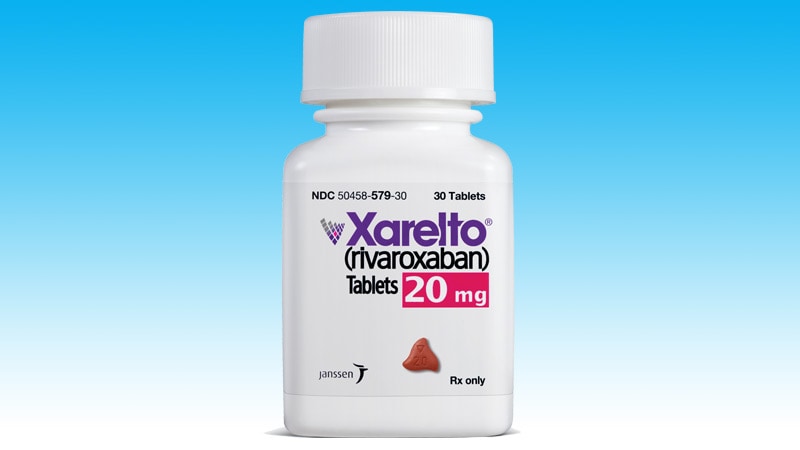
In stable patients hospitalized with COVID-19 and elevated D-dimer levels, therapeutic anticoagulation with rivaroxaban 20 mg once daily did not improve clinical outcomes but did increase bleeding compared with in-hospital prophylactic anticoagulation in the ACTION trial.
The trial also intended to test a therapeutic regimen of enoxaparin (1 mg/kg twice daily) in unstable patients but did not include enough of these patients for meaningful results.
The ACTION trial was presented by Renato Lopes, MD, professor of medicine at Duke University Medical Center, Durham, North Carolina, May 16 at the virtual American College of Cardiology (ACC) 2021 Scientific Sessions.

Dr Renato Lopes
Lopes explained that rivaroxaban is a widely used and efficacious anticoagulant for patients with atrial fibrillation, deep venous thrombosis (DVT), and pulmonary embolism (PE). It is also being used in some centers to try and prevent thromboembolic events in COVID-19 patients, but there are no data on the optimum dosage or duration of therapy for this situation.
“An oral drug would be very attractive in moderately ill patients as there is a hypothesis that the inflammation and prothrombotic state continues after hospital discharge,” he said.
“The ACTION trial was powered to show superiority of rivaroxaban 20 mg over prophylactic anticoagulation, but our results actually trended in the other direction. Although there was a modest reduction in thromboembolic events with rivaroxaban, there was also a nonsignificant increase in mortality and a very pronounced increase in bleeding. The trade-off is not favorable,” Lopes told theheart.org | Medscape Cardiology.
The results of this trial contrast with a large US program of trials that has recently been reported to show a benefit of full-dose anticoagulation with heparin vs prophylactic anticoagulation in moderately ill COVID-19 patients.
Top-line results from an international platform of three linked clinical trials — REMAP-CAP, ACTIV-4, and ATTACC — were announced in January and said to show that a full therapeutic dose of heparin was superior to low prophylactic doses for the primary endpoint of need for ventilation or other organ supportive interventions at 21 days after randomization. These trials have not yet been published and safety results have not yet been reported, other than to say the risk-benefit was favorable to full-dose heparin.
Earlier results from the same platform of three trials had shown no benefit but an increased bleeding rate in critically ill COVID patients, and these patients had stopped being enrolled in the studies.
Asked how the overall data from all the trials available should be interpreted, Lopes said the ACTION trials and the international platform of trials were very different and should not be directly compared.
“We tested rivaroxaban; they used heparin as the therapeutic strategy. They looked at in-hospital outcomes; we had 30-day outcomes as our endpoint,” Lopes noted.
“I think we need for the trials to be published so we can interpret the data fully before making clinical recommendations,” he added. “There are also many other trials currently underway and results from all of them should be available in the next few months. We will be in a much better position to know what to do then.”
“For now,” he said, “we can say that based on ACTION, that we should not be using rivaroxaban at a dose of 20 mg once daily for thrombotic prophylaxis in stable COVID-19 patients who do not have another indication for anticoagulation such as DVT or PE.”
The ACTION trial was conducted in Brazil to assess whether a strategy of therapeutic anticoagulation primarily with rivaroxaban is effective in preventing complications in patients hospitalized with COVID-19 and elevated D-dimer levels compared with prophylactic anticoagulation.
The trial randomized 615 such patients to therapeutic anticoagulation or standard of care in-hospital prophylactic anticoagulation, normally low dose (40 mg) enoxaparin once daily.
Two different therapeutic strategies were employed for two different patient groups. Stable patients received therapeutic anticoagulation with rivaroxaban 20 mg daily and unstable patients received in-hospital enoxaparin (1 mg/kg) twice daily.
Both groups received rivaroxaban 20 mg after hospital discharge through to 30 days.
The primary outcome was a hierarchical analysis of mortality, duration of hospitalization, and duration of oxygen use through 30 days using the “unmatched win ratio” method.
Lopes explained that this involved comparing each patient in the treatment group with each patient in the control group for the three individual components of the composite endpoint. For example, for mortality, if the treatment patient survives and the control patient dies, that is a win for the treatment. If the control patient survives and treatment patient dies that is a win for the control. If the result is the same, that is a tie.
The win ratio is calculated by the number of wins in the treatment group divided by the number of wins in the control group. If the ratio is more than 1, then the treatment is beneficial.
Baseline characteristics of the patients enrolled showed that more than 90% were classified as stable, with around 75% needing oxygen support; 90% were already on anticoagulants (most on standard prophylaxis), 8% were taking antiplatelet medication, and 83% were on systemic corticosteroids.
Results showed that there were 34.8% wins in the therapeutic strategy vs 41.3% in the prophylactic strategy, with 23.9% ties. This gave a win ratio of 0.86 (95% CI, 0.59 – 1.22) for the therapeutic vs prophylactic strategy.
The same patterns were seen for each individual component of the composite primary endpoint.
The therapeutic group showed numerically lower rates of thromboembolic events (relative risk [RR], 0.75; 95% CI, 0.45 – 1.26), but also numerically higher rates of 30-day mortality (RR, 1.49; 95% CI, 0.90 – 2.46).
There was also a significant increase in major or clinically relevant bleeding in the therapeutic group (8.4% vs 2.3%), giving a RR of 3.64.
Results were similar across all subgroups.
One of the Big Questions
Commenting on the study at the ACC session, Robert Harrington, MD, professor of medicine at Stanford University, California, said the Brazilian trial had tackled one of the big questions in COVID-19 — the optimum dose of anticoagulation to use — but it tackled it differently to the studies that have been performed in the US, in trying to address whether different strategies were needed in stable and unstable patients. He asked Lopes what the study had shown on this.
Lopes replied that the primary aim was to test therapeutic dose of rivaroxaban, but they wanted to allow the use of heparin in unstable patients. “It turns out that the vast majority of patients were stable, and we really didn’t have enough unstable patients to answer that question,” he said.
“Our trial should be focused primarily on stable patients on an oral drug, and that’s what this trial adds to the field,” Lopes stated.
Harrington agreed with Lopes’ interpretation of the differing results in this trial and the international platform studies.
“There were different regimens used in the two trials. We should stick with the data from the platform studies on heparins in therapeutic doses for moderately ill patients,” he told theheart.org | Medscape Cardiology.
On the “win ratio” methodology, Harrington explained that this type of analysis has been introduced as way to address some limitations of the traditional “time-to-event” analysis, which only includes the first event that occurs in the primary analysis.
“Sometimes this might not be the most important event (for example, MI rather than death; revascularization rather than MI),” he said. “The ‘win ratio’ allows all the events to be examined and compared across the treatments.”
Harrington said the ACTION investigators should be given “kudos” for putting the win ratio methodology into practice. “It is nice to see this used in a real clinical trial.”
The ACTION trial was an academic-led study funded by an unrestricted research grant from Bayer. Lopes reported research grants from Amgen, Bristol-Myers Squibb, GlaxoSmithKline, Bayer, Medtronic, Pfizer, and Sanofi-Aventis, and funding for consulting or educational activities from Bayer, Boehringer Ingelheim, Bristol-Myers Squibb, Pfizer, Daiichi Sankyo, and Portola.
American College of Cardiology (ACC) 2021 Scientific Session. Presented May 16, 2021.
For more from theheart.org | Medscape Cardiology, follow us on Twitter and Facebook.
No comments:
Post a Comment